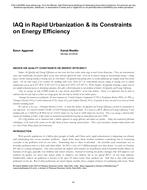Description
Indoor Air Quality and Energy Efficiency are two issues that have taken centre-stage in most Green discussions. These are interconnected issues and traditionally, the positive effects of one, have inversely affected the other. If we try to conserve energy by incrementally closing / sealing spaces, thereby reducing cooling or heating costs, we risk Indoor Air Quality from getting worse as various pollutants get trapped inside these closed spaces. On the other hand, if we ventilate our buildings with extra "fresh air", we substantially increase cooling or heating costs as outside temperatures can go up to 45°-50°C (110°-122° F) or down to 0°-10°C (32°-50° F). With Outdoor Air Quality becoming a major issue in our rapidly urbanized spaces in developing economies, this adds a third dimension to our problem of Indoor Air Quality and Energy Efficiency. Also, on average, we take 23,000 breaths in a day and we spend 80%+ of our time indoors. Hence, it is imperative that we look at solutions that not only help us achieve our energy goals, but also keep us healthy in our indoor spaces.
Amongst the common air pollutants, the most common are Volatile Organic Compounds (VOCs), Particulate Matter (PM10 & PM2.5), Nitrogen Dioxide (NO2), Carbon Monoxide (CO), Ozone (O3) and Sulphur Dioxide (SO2). Exposure to these can lead to an array of health disorders including death.
We will use a test case – Paharpur Business Centrei – to show how Indoor Air Quality and Energy Efficiency can both be maintained at very high levels. It is the first retrofit USGBC LEED Platinum building in India. It is rated as a BEE (Bureau of Energy Efficiency) 5 Star building with an AAhEPI of 28 Whr/hr/m2 (23.411 Joule/Sec/Sq Yard or 2.601 Joule/Sec/Sq Feet). This is on average a third of other commercial buildings in India. IAQ results are monitored and published everyday on www.pbcnet.com since 1996.
The IAQ problem can be combated with a holistic approach to energy efficiency and indoor air quality. Along side mechanical filtration technologies, at the heart of the system are the right kinds of toxin removing natural plants. Three easy-to-maintain, common indoor plants used are Areca Palm, Money plant and Sansevieria.
Product Details
- Published:
- 2014
- Number of Pages:
- 8
- File Size:
- 1 file , 2.4 MB
- Product Code(s):
- D-2014EHPB-9
- Note:
- This product is unavailable in Russia, Belarus




